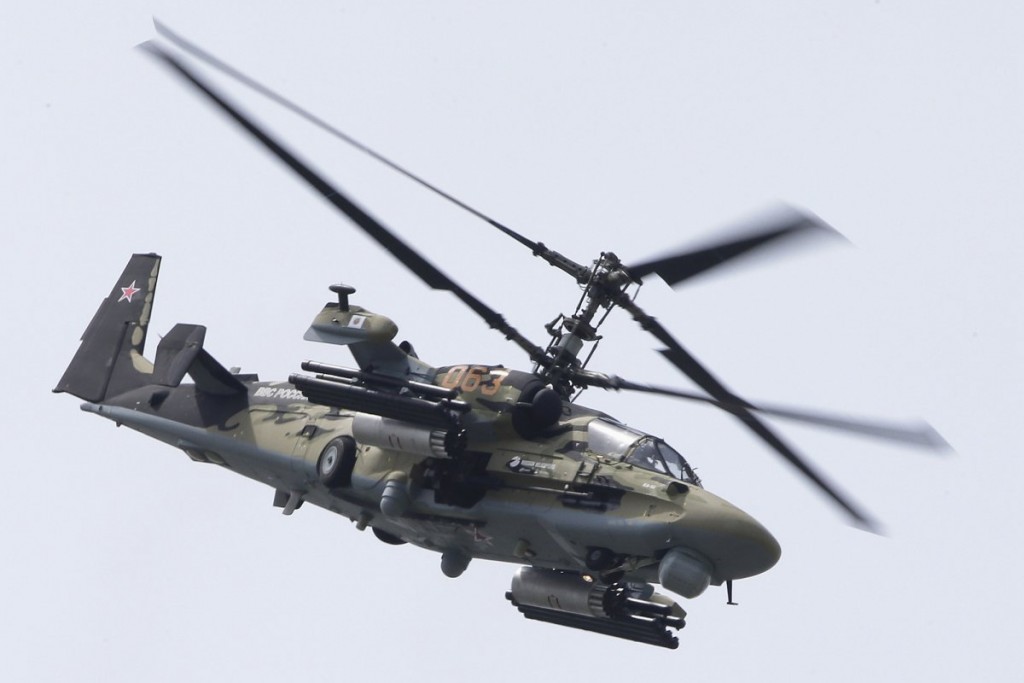Sourced : Reuters
By : Jack Stubbs and Maria Tsvetkova,
A month since Vladimir Putin announced the withdrawal of most Russian forces from Syria, his military contingent there is as strong as ever, with fewer jets but many more attack helicopters able to provide closer combat support to government troops.
A Reuters analysis of publicly available tracking data shows no letup in supply missions: the Russian military has maintained regular cargo flights to its Hmeimim airbase in western Syria since Putin’s declaration on March 14.
Supply runs have also continued via the “Syrian Express” shipping route, Russian engineering troops have been deployed to the ancient city of Palmyra and further information has surfaced about Russian special forces operating in Syria – suggesting the Kremlin is more deeply embroiled in the conflict than it previously acknowledged.
“There hasn’t been a drawdown in any meaningful way,” said Nick de Larrinaga, Europe Editor of IHS Jane’s Defence Weekly. “Russia’s military presence in Syria is just as powerful now as it was at the end of 2015.”
Announcing a drawdown gave Putin some breathing space from Western political pressure over the operation, and an opportunity to carry out maintenance on heavily-used jets.
But by keeping a strong military force in place, Putin is maintaining his power to influence the situation in Syria by shoring up President Bashar al-Assad, Moscow’s closest ally in the Middle East.
He will also want to secure Russia’s role in efforts to broker a resolution to the conflict – a process the Kremlin has used to reassert itself as a global political power after being ostracized by the West over the Ukraine crisis.
As recently as Thursday, photos and video footage taken by Turkish bloggers for their online project Bosphorus Naval News showed a Russian Navy landing ship – the Saratov – en route to Russia’s Tartous naval facility in the western Syrian province of Latakia loaded with at least ten military trucks.
The Saratov is a regular feature on Russia’s “Syrian Express” shipping route, which Moscow has used to transport increased supplies and equipment to Syria since the military draw down was announced.
The Russian Defence Ministry did not respond to written questions submitted by Reuters.
“More formidable force”
Russian troops and equipment have also been deployed to Syria by air in recent weeks.
An Ilyushin Il-76 cargo plane operated by the Russian Air Force under registration number RA-78830 has flown two supply trips a month to Syria since December. Its last flight to Russia’s Latakia airbase was on April 9-10 according to tracking data on website FlightRadar24.com.
Able to carry up to 145 people or 50 tonnes of equipment, Il-76 planes have been used to transport heavy vehicles including helicopters to Syria, a Russian Air Force colonel told Reuters, bolstering the number of gunships in the country as Russia’s jet force deployment is wound down.
“We removed some planes and added helicopters. We don’t need mass bomb drops during a ceasefire,” the colonel said. “Helicopters fly lower and can observe the territory better.”
Russia now has more than 30 helicopters operating in Syria, including a fleet of around eight Mi-28N Night Hunter and Ka-52 Alligator gunships stationed at its Shayrat airbase southeast of Homs city, according to satellite images posted online by IHS Jane’s analysts.
Separate images show 22 jets and 14 helicopters stationed at the Hmeimim airbase, compared to 29 jets and 7 helicopters seen there in early February, said Justin Bronk, a research fellow at the Royal United Services Institute (RUSI).
“All that’s really gone is the fixed wing close air support attack jets,” he said. “On the rotary side it’s a substantially more formidable force than it was.”
Special forces
The Ka-52, known for its unusual double set of top-mounted rotor blades and no tail rotor, is the Russian military’s official special forces support helicopter and its appearance in Syria is testament to the growing number of Russian ground troops in direct combat roles, western officials say.
Russia acknowledged having special forces in Syria for the first time shortly after its military drawdown was announced, saying they were conducting high-risk reconnaissance missions and “other special tasks”.
Since the announcement, Western diplomats say Russia’s forces have increasingly targeted Islamic State militants and an offshoot of al Qaeda. Previously Russia focused its strikes on other Assad opponents, including some viewed by the West as moderate.
Swapping jets for helicopters illustrates Russia’s new military role in the Syrian conflict, engaging directly with fighting on the ground instead of dropping bombs from thousands of feet.
“Russia’s attack helicopters are getting much more into the thick of things than their fixed wing aircraft were previously,” said de Larrinaga. “We never really saw Russian strike aircraft operating at low level like this before.”
Both the Ka-52 and Mi-28N, which is broadly equivalent to the U.S. Apache gunship, were used to provide close air cover to the Syrian army when it secured a major victory by retaking Palmyra from Islamic State militants in March.
Bronk said the helicopter deployment was in response to the changing needs of the Syrian army.
“They are no longer bombarding besieged cities so much, trying to dislodge rebels,” he said. “Instead they are trying to assist a more mobile, maneuverable style of engagement.”
“Because that tactical role or focus of Assad’s forces has changed, then the Russian support methodology needs to change along with it.”


